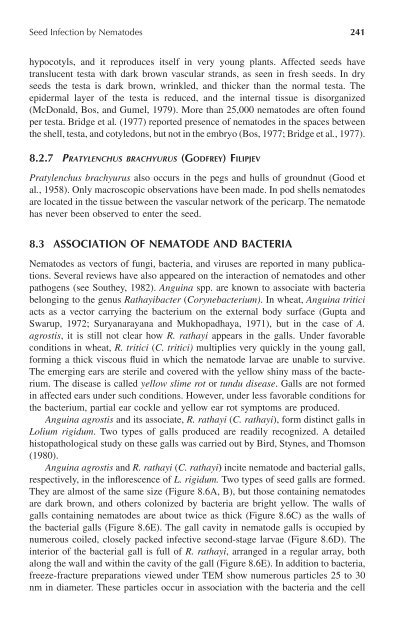Histopathology of Seed-Borne Infections - Applied Research Center ...
Histopathology of Seed-Borne Infections - Applied Research Center ...
Histopathology of Seed-Borne Infections - Applied Research Center ...
Create successful ePaper yourself
Turn your PDF publications into a flip-book with our unique Google optimized e-Paper software.
<strong>Seed</strong> Infection by Nematodes 241hypocotyls, and it reproduces itself in very young plants. Affected seeds havetranslucent testa with dark brown vascular strands, as seen in fresh seeds. In dryseeds the testa is dark brown, wrinkled, and thicker than the normal testa. Theepidermal layer <strong>of</strong> the testa is reduced, and the internal tissue is disorganized(McDonald, Bos, and Gumel, 1979). More than 25,000 nematodes are <strong>of</strong>ten foundper testa. Bridge et al. (1977) reported presence <strong>of</strong> nematodes in the spaces betweenthe shell, testa, and cotyledons, but not in the embryo (Bos, 1977; Bridge et al., 1977).8.2.7 PRATYLENCHUS BRACHYURUS (GODFREY) FILIPJEVPratylenchus brachyurus also occurs in the pegs and hulls <strong>of</strong> groundnut (Good etal., 1958). Only macroscopic observations have been made. In pod shells nematodesare located in the tissue between the vascular network <strong>of</strong> the pericarp. The nematodehas never been observed to enter the seed.8.3 ASSOCIATION OF NEMATODE AND BACTERIANematodes as vectors <strong>of</strong> fungi, bacteria, and viruses are reported in many publications.Several reviews have also appeared on the interaction <strong>of</strong> nematodes and otherpathogens (see Southey, 1982). Anguina spp. are known to associate with bacteriabelonging to the genus Rathayibacter (Corynebacterium). In wheat, Anguina triticiacts as a vector carrying the bacterium on the external body surface (Gupta andSwarup, 1972; Suryanarayana and Mukhopadhaya, 1971), but in the case <strong>of</strong> A.agrostis, it is still not clear how R. rathayi appears in the galls. Under favorableconditions in wheat, R. tritici (C. tritici) multiplies very quickly in the young gall,forming a thick viscous fluid in which the nematode larvae are unable to survive.The emerging ears are sterile and covered with the yellow shiny mass <strong>of</strong> the bacterium.The disease is called yellow slime rot or tundu disease. Galls are not formedin affected ears under such conditions. However, under less favorable conditions forthe bacterium, partial ear cockle and yellow ear rot symptoms are produced.Anguina agrostis and its associate, R. rathayi (C. rathayi), form distinct galls inLolium rigidum. Two types <strong>of</strong> galls produced are readily recognized. A detailedhistopathological study on these galls was carried out by Bird, Stynes, and Thomson(1980).Anguina agrostis and R. rathayi (C. rathayi) incite nematode and bacterial galls,respectively, in the inflorescence <strong>of</strong> L. rigidum. Two types <strong>of</strong> seed galls are formed.They are almost <strong>of</strong> the same size (Figure 8.6A, B), but those containing nematodesare dark brown, and others colonized by bacteria are bright yellow. The walls <strong>of</strong>galls containing nematodes are about twice as thick (Figure 8.6C) as the walls <strong>of</strong>the bacterial galls (Figure 8.6E). The gall cavity in nematode galls is occupied bynumerous coiled, closely packed infective second-stage larvae (Figure 8.6D). Theinterior <strong>of</strong> the bacterial gall is full <strong>of</strong> R. rathayi, arranged in a regular array, bothalong the wall and within the cavity <strong>of</strong> the gall (Figure 8.6E). In addition to bacteria,freeze-fracture preparations viewed under TEM show numerous particles 25 to 30nm in diameter. These particles occur in association with the bacteria and the cell


